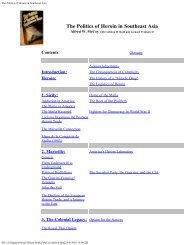Addiction and Opiates
Addiction and Opiates
Addiction and Opiates
Create successful ePaper yourself
Turn your PDF publications into a flip-book with our unique Google optimized e-Paper software.
CHAPTER 9 THE PROBLEM IN THE UNITED STATES DURING THE NINETEENTH CENTURY<br />
"Opium smoking had been entirely confined to the Chinese up to <strong>and</strong> before the autumn of 1876, when the practice<br />
was introduced by a sporting character who had lived in China, where he had contracted the habit. He spread the<br />
practice amongst his class, <strong>and</strong> his mistress, a woman of the town, introduced it among her demi-monde acquaintances,<br />
<strong>and</strong> it was not long before it had widely spread amongst the people mentioned <strong>and</strong> then amongst the younger class of<br />
boys <strong>and</strong> girls, many of the latter of the more respected class of families. The habit grew very rapidly until it reached<br />
young women of more mature age, when the necessity for stringent measures became apparent, <strong>and</strong> was met by the<br />
passing of a city ordinance."(12)<br />
Considerable numbers of Chinese arrived in the United States during the 1850's; there were thous<strong>and</strong>s in the West by<br />
186o. (13) It seems incredible, therefore, that no white man should have tried the drug before 1868. An addict who<br />
began to smoke opium while he was in the West in 1906 told me that, although he had heard about the account given<br />
by Kane, he was disposed to regard it as legend. At any rate, the denizens of the American underworld acquired the<br />
habit from the Chinese, who taught them the ritual <strong>and</strong> the technique <strong>and</strong> at first supplied the drug. The Chinese<br />
influence upon the use of narcotics is evident in many words in the addict's argot. (14)<br />
According to Kane:<br />
The very fact that opium smoking was a practice forbidden by law seemed to lead many who would not otherwise have<br />
indulged to seek out the low dens <strong>and</strong> patronize them, while the regular smokers found additional pleasure in<br />
continuing that about which there was a spice of danger. It seemed to add zest to their enjoyment. Men <strong>and</strong> women,<br />
young girls, virtuous or just commencing a downward career, hardened prostitutes, representatives of the "hoodlum"<br />
element, young clerks <strong>and</strong> err<strong>and</strong> boys who could ill afford the waste of time <strong>and</strong> money, <strong>and</strong> young men who had no<br />
work to do were to be found smoking together in the back rooms of laundries in the low, pestilential dens of<br />
Chinatown, reeking with filth <strong>and</strong> overrun with vermin, in the cellars of drinking saloons, <strong>and</strong> in houses of<br />
prostitution.(15)<br />
The San Francisco Chronicle of July 25, 1881., stated that "the habit in past years, so far as whites are concerned, was<br />
confined to hoodlums <strong>and</strong> prostitutes mostly." It added, "Now that there are scores of places where the habit can be<br />
contracted in clean rooms in respectable portions of the city, the practice will gradually extend up in the social<br />
grade."(16)<br />
The rapidity with which the opium-smoking habit spread was noted by an anonymous writer in Chambers' journal in<br />
1888:<br />
In 1877 <strong>and</strong> 1878 when Deadwood, the Metropolis of the Black Hills, one of the richest mining camps ever discovered<br />
in the United States, was over 300 miles from the nearest railroad, it was ascertained that the Chinamen had introduced<br />
the vice of opium-smoking among the white inhabitants. I was employed at the time as deputy sheriff, <strong>and</strong> received<br />
instructions to investigate the subject with a view to closing the houses <strong>and</strong> punishing the proprietors.(17)<br />
Action taken by local authorities was apparently not very effective, for former smokers state that as late as 1910 they<br />
were able to travel almost anywhere in the West without taking along either a supply of opium or an opium pipe,<br />
depending solely upon the dens that operated in almost all sizeable towns.<br />
The opium smoker of the nineteenth century belonged to an elite underworld group which despised <strong>and</strong> generally<br />
avoided all contact with the hypodermic user or "opium eater" of respectable society. Smokers usually regarded the<br />
hypodermic habit as more vicious <strong>and</strong> difficult to break than the smoking habit. They applied the term "dope fiend" to<br />
those who used the drug in some manner other than smoking, but did not apply it to themselves. Their attitudes were<br />
indicated by an incident that occurred early in the twentieth century in a New York opium-smoking joint. One of the<br />
smokers discovered a hypodermic user in the bathroom giving himself an injection. He immediately reported to the<br />
proprietor that there was a "God-damned dope fiend in the can." The offender was promptly ejected.<br />
Unlike opium eating, the smoking habit did not involve contact with the medical profession, for doctors did not<br />
prescribe it. Hence, the habit spread solely through contacts with persons who were already addicted, <strong>and</strong> this is the<br />
manner in which drug addiction in the underworld has continued to spread. A special committee of investigation<br />
appointed in 1918 by the Secretary of the Treasury stated: "with respect to the addict of good social st<strong>and</strong>ing, the<br />
file:///I|/drugtext/local/library/books/adopiates/chapter9.htm[24-8-2010 14:23:39]





